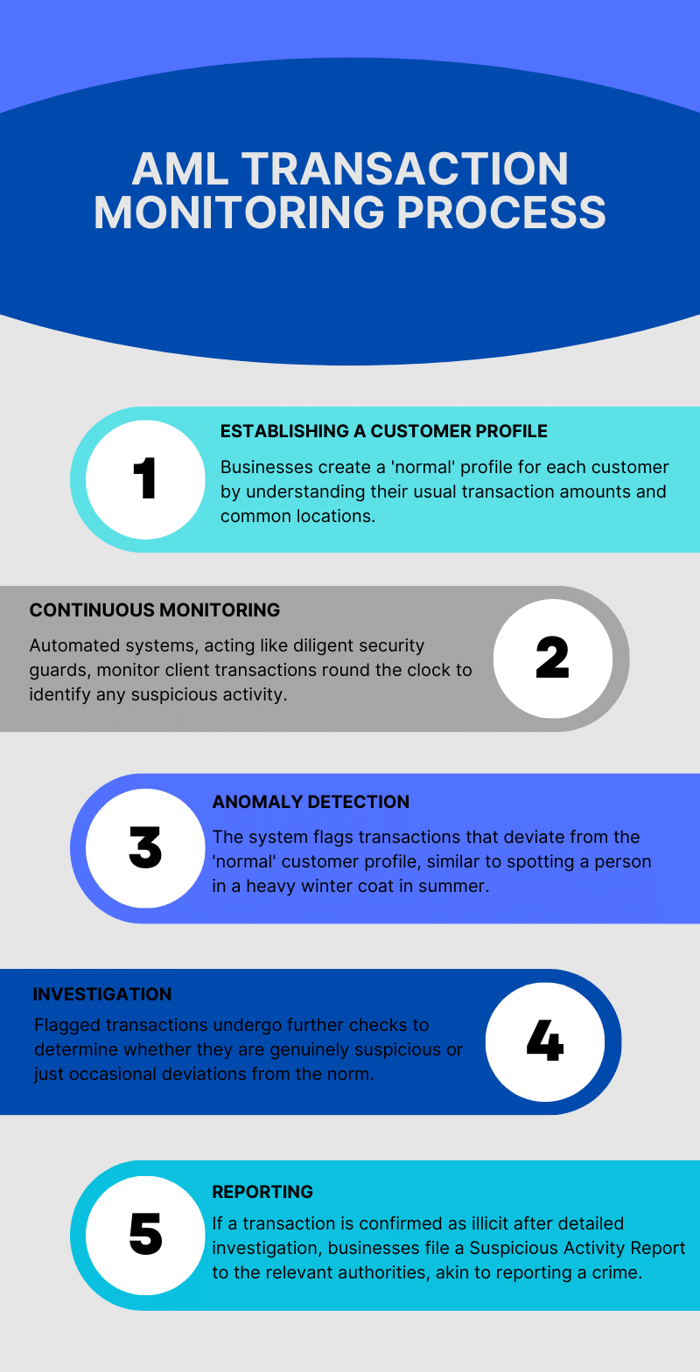In today's financial landscape, the challenges associated with transaction monitoring for Anti-Money Laundering (AML) compliance are becoming increasingly complex. Financial institutions must grapple with a number of issues to ensure the effectiveness of their transaction monitoring program. This article delves into the top challenges faced by organizations. Furthermore, it explores strategies for overcoming these hurdles.
Top 7 Challenges in Transaction Monitoring
1. The Global Nature of Transactions
The global nature of financial transactions presents a formidable challenge in the realm of AML compliance. As capital moves seamlessly across borders, monitoring and scrutinizing each transaction becomes a complex undertaking. Financial institutions must contend with diverse regulatory environments, varying reporting standards, and disparate transaction patterns. The interconnectedness of the global financial system requires sophisticated and continuous transaction monitoring systems capable of identifying suspicious activities in real time.
2. Transition Challenges: Adapting to Evolving Regulatory Landscape
Transitioning in the face of an ever-evolving regulatory landscape poses significant challenges for financial institutions engaged in transaction monitoring. The regulatory environment governing AML is ever-changing, with frequent updates and amendments. Adapting to these changes requires a proactive and agile approach, encompassing not only the integration of new compliance measures but also the seamless adjustment of existing systems.
3. Staying Updated with Evolving Compliance Requirements
Staying updated with evolving compliance requirements is a perpetual challenge. Regulatory frameworks are subject to frequent updates. This demands a constant commitment to education and adaptation. Financial institutions must establish mechanisms for continuous monitoring of regulatory changes, ensuring that their transaction monitoring programs remain aligned with the latest standards. This necessitates a culture of vigilance, proactive engagement with regulatory updates, and a commitment to ongoing education to mitigate the risks associated with non-compliance.
4. Operational Challenges: Balancing Accuracy and Efficiency
Operational challenges in transaction monitoring revolve around striking a delicate balance between accuracy and efficiency. Ensuring thorough scrutiny of transactions for AML compliance is crucial, but it must not hinder the swift flow of legitimate transactions. Financial institutions face the ongoing challenge of optimizing their monitoring systems to identify suspicious activities accurately while maintaining operational efficiency. This requires constant refinement of processes, leveraging advanced technologies, and adopting a dynamic approach to transaction monitoring that adapts to the evolving nature of financial transactions and money laundering tactics.
5. Managing False Positives: Reducing the Burden of Manual Reviews
Effectively managing false positives is a pivotal challenge in transaction monitoring for AML compliance. The high volume of alerts that turn out to be legitimate transactions burdens compliance teams with manual reviews, impeding efficiency. Financial institutions must implement strategies to minimize false positives, such as refining rule-based systems, incorporating machine learning algorithms, and continually fine-tuning alert thresholds. This not only reduces the workload on compliance teams but also enhances the accuracy of identifying genuinely suspicious transactions, ensuring a more streamlined and effective AML compliance process.
6. Evading Static Rule-Based Systems
The challenge of evading static rule-based systems is a critical concern in transaction monitoring for AML. Traditional rule-based approaches struggle to keep pace with evolving money laundering techniques, as criminals adapt their strategies. To address this challenge, financial institutions are increasingly turning towards dynamic, adaptive systems driven by artificial intelligence. These systems can analyze complex patterns, detect anomalies, and evolve in real time, providing a more robust defence against sophisticated money laundering activities.
7. Data Challenges in AI Deployment
Deploying Artificial Intelligence (AI) in transaction monitoring introduces specific challenges related to data. Ensuring the quality, accuracy, and relevance of data inputs is crucial for the success of AI-driven systems. Financial institutions face the task of cleansing and validating data to enhance the effectiveness of AI algorithms. Overcoming data challenges involves implementing robust data governance practices and leveraging advanced data management techniques to ensure the reliability and integrity of information used in AI-based transaction monitoring.

Consequences of Non-Compliance in Transaction Monitoring
Non-compliance can have severe consequences for financial institutions. Apart from potential legal actions, the penalty for non compliance with transaction monitoring obligation can tarnish the reputation of the organization and result in loss of trust among clients and partners.
Navigating Challenges: Approaches for Successful Transaction Monitoring
1. Enhancing Compliance Culture and Training
Promoting a Compliance Culture
Fostering a culture of compliance within the organization is foundational to effective transaction monitoring. Employees at all levels should understand the importance of AML compliance and actively contribute to maintaining a vigilant environment.
Comprehensive Training Programs
Regular and comprehensive training programs are essential for keeping staff informed about the latest developments in AML regulations. Training sessions should cover the details of transaction monitoring and equip employees with the skills needed to navigate the AML challenges.
2. Regulatory Collaboration and Information Sharing
Regulatory collaboration and information sharing play a pivotal role in overcoming compliance challenges in transaction monitoring. Financial institutions benefit from actively engaging with regulatory bodies, fostering an environment of open communication and collaboration. Participation in industry forums, sharing insights, and collaborating on best practices enable a collective response to emerging risks. Such collaborative efforts facilitate a more comprehensive understanding of money laundering trends, enhancing the effectiveness of transaction monitoring programs and promoting a unified approach to compliance within the financial industry.
3. Adhering to Key Regulatory Frameworks
Adhering to key regulatory frameworks is foundational for effective transaction monitoring in AML compliance. Financial institutions must navigate a complex web of regulations and standards. This involves not only understanding the intricacies of AML laws but also aligning transaction monitoring programs with specific regulatory requirements. A proactive approach to compliance ensures that organizations mitigate risks, uphold industry standards, and maintain the trust of regulators and stakeholders.
4. Collaborative Approach to Compliance
A collaborative approach to compliance is essential for addressing challenges in transaction monitoring. Breaking down silos within financial institutions, departments such as risk management, compliance, and IT must work synergistically. This collaborative effort ensures a holistic understanding of compliance monitoring techniques, fostering a unified strategy. By promoting cross-functional collaboration, organizations can develop and implement robust transaction monitoring programs that effectively navigate the complexities of AML regulations.
Implementing Advanced Technology Solutions for Transaction Monitoring
Financial institutions are embracing advanced technology solutions to boost their transaction monitoring activities in the face of evolving challenges. Tookitaki's innovative products demonstrate this shift by harnessing cutting-edge AI-driven capabilities. Unlike traditional rule-based systems, Tookitaki's solutions offer a dynamic and adaptive approach to AML compliance.
By leveraging artificial intelligence, these systems can analyze complex transaction patterns, identify anomalies, and evolve in real time to counter sophisticated money laundering tactics. This not only enhances detection accuracy but also positions financial institutions at the forefront of proactive AML compliance, ensuring a more robust defence against emerging threats in the ever-changing financial landscape.
Anti-Financial Crime Compliance with Tookitaki?

.webp?width=800&height=1569&name=b1f64d82-839a-4bb7-acae-c09980e2a43f%20(1).webp)


